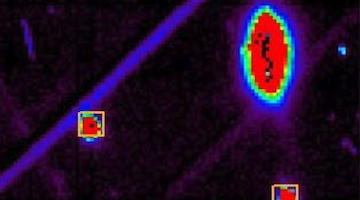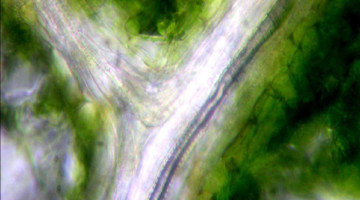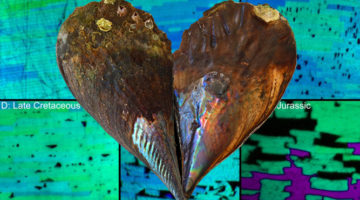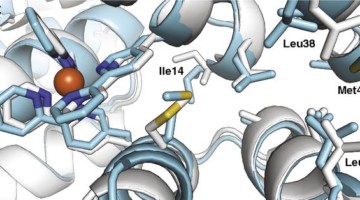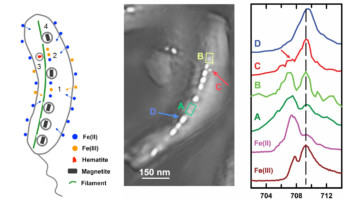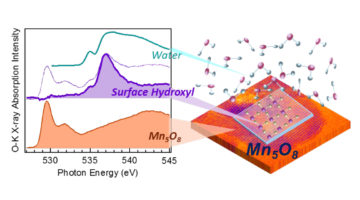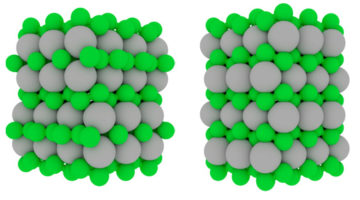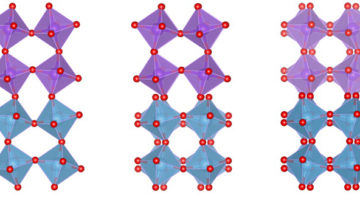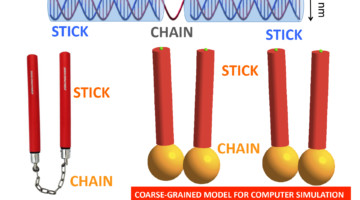A group of scientists used Laue x-ray microdiffraction at the ALS to probe plastic deformation mechanisms at the nanoscale. Their findings may overturn conventional theory and reshape our understanding of the mechanical behavior of a host of nanocrystalline metals. Read more »
Science Briefs
3D Visualization of Leaves during Drought
The veins of living leaves at increasing levels of drought stress were visualized using x-ray microtomography. The results expand our view of leaf drought responses, beyond the traditional embolism-centric view, to a broader focus on the role of the surrounding living tissues in water movement during drought. Read more »
Ancient Ocean Temperatures Recorded in Mother-of-Pearl
Researchers have shown that the thickness of the nacre, or mother-of-pearl, that lines the insides of mollusk shells can be used to estimate ocean temperatures as far back as the early Jurassic period. X-ray studies of modern and ancient shells help establish the method’s feasibility. Read more »
NCAA Drives Formation of Designed Proteins
A noncanonical amino-acid (NCAA) complex has been found to drive the self-assembly of a computationally designed protein. Bpy-ala, which is “noncanonical” because it’s not among the 20 amino acids that occur naturally, has useful properties that could be used to generate novel photoactive proteins. Read more »
Ptychography of a Bacterium’s Inner Compass
Magnetotactic bacteria (MTB) synthesize chains of magnetic nanocrystals (magnetosomes) that interact with the Earth’s magnetic field like an inner compass needle, simplifying their search for optimum environments. Ptychographic spectra of magnetosomes from a marine MTB provides insight into how these inner compasses form. Read more »
For Better Batteries, Open the Voltage Window
Electrochemical (battery) cells with aqueous electrolytes can be safe, inexpensive, and environmentally friendly, but they are limited by a narrow voltage window. X-ray absorption spectroscopy helps explain why an aqueous Na-ion system with Mn5O8 electrodes has a large voltage window and performs comparably to Li-ion batteries. Read more »
Testing the Limits of Superhard Rhenium/Tungsten Diboride
Superhard materials such as metal borides are in demand as structural and engineering compounds and for next-generation cutting tools. Researchers have now synthesized a “solid solution” of two different metal borides, demonstrating the accuracy of theoretical predictions and opening the door to more targeted tuning of desirable characteristics. Read more »
Self-Assembly of a Programmable DNA Lattice
The use of DNA for nanotechnology has gained interest because it is a highly “programmable” polymer with “sticky ends,” allowing the self-assembly of molecular scaffolds for other proteins and molecules. Their high-resolution structures will help map new routes toward the rational design of self-assembling 3D DNA crystals. Read more »
Magnetism Emerges at Wonky Interfaces
Researchers have found a new way to control magnetism at the atomic level that will serve as a model for studying emergent phenomena in other systems. The ability to engineer and tune properties on such small length scales can (eventually) enable us to design exciting new magnetic devices. Read more »
The Smectic Phase of DNA “Nano-Nunchaku”
Researchers designed DNA sequences that self-assemble into a nanoparticle about 50 nm long, composed of two double-stranded DNA duplexes linked together by a single-stranded DNA filament. The nanoparticle resembles nunchaku—a traditional weapon of several martial arts—but 30 million times smaller. Read more »
- « Previous Page
- 1
- …
- 16
- 17
- 18
- 19
- 20
- …
- 23
- Next Page »
